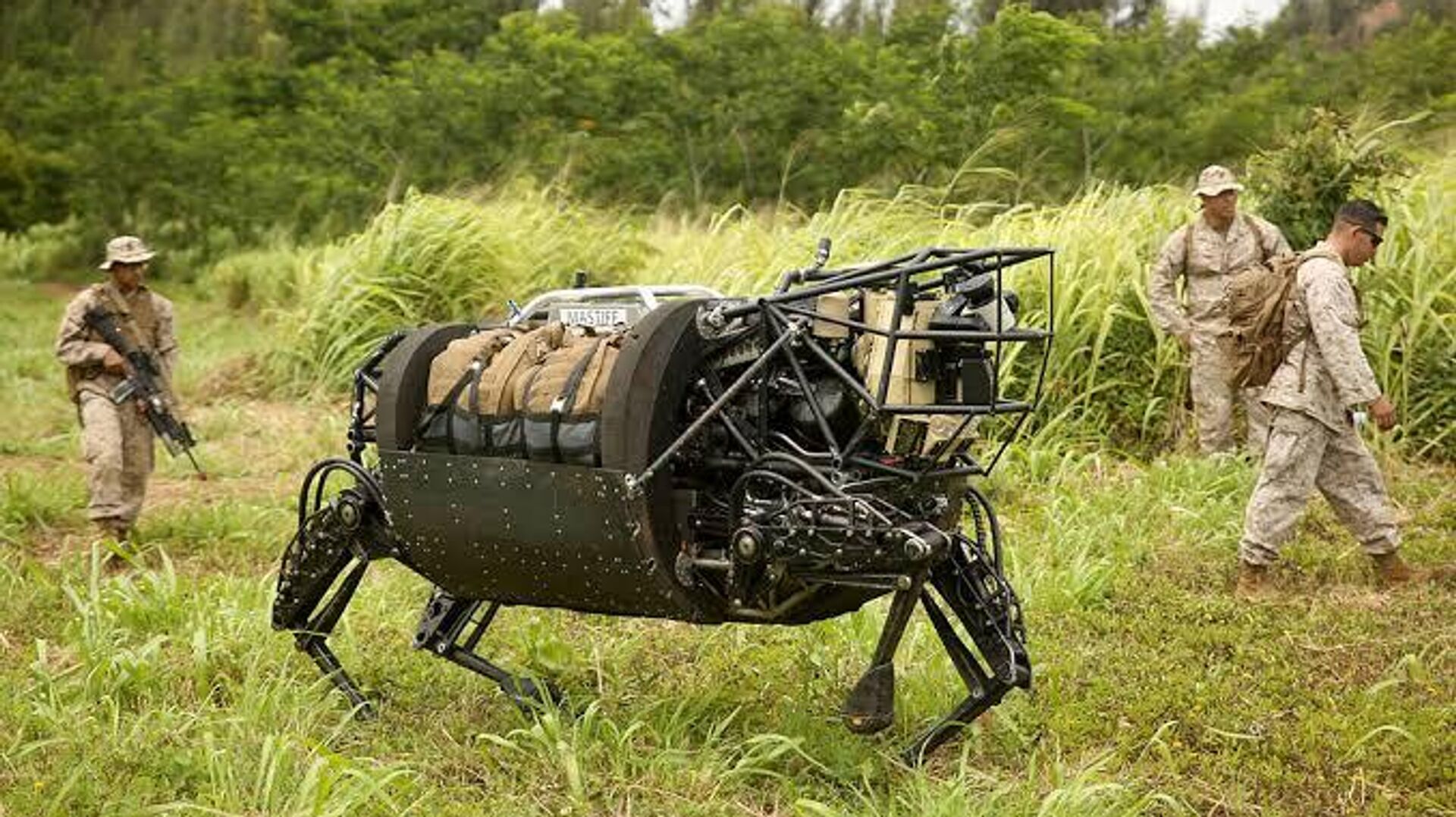https://sputniknews.in/20240903/new-robo-mules-and-drones-indias-leap-forward-in-logistics-8098281.html
New Robo-Mules and Drones: India's Leap Forward in Logistics
New Robo-Mules and Drones: India's Leap Forward in Logistics
Sputnik India
Load-carrying drones can greatly decrease the reliance on helicopters by delivering supplies over obstacles without bridges, and get closer to enemy positions... 03.09.2024, Sputnik India
2024-09-03T21:30+0530
2024-09-03T21:30+0530
2024-09-03T21:30+0530
defenсe news
india
china
defense sector
ministry of defence (mod)
ministry of external affairs (mea)
south china sea
government of india
drone
man portable counter drone system (mpcds)
https://cdn1.img.sputniknews.in/img/07e8/09/03/8102854_0:36:678:417_1920x0_80_0_0_efa01ef382defb8bdb6922d337c8e458.jpg
The Indian army is making major efforts to reduce its reliance on animals for supplying soldiers at forward posts along the border.Alongside developing robotic mules, the army is buying more logistics drones and improving infrastructure in these isolated areas, according to sources quoted by India Today.In mountainous regions, the army is gradually replacing beasts of burden with trucks, all-terrain vehicles and rugged-terrain vehicles to improve last-mile delivery.Although pack animals have been crucial due to the challenging terrain, the increasing infrastructure is expected to reduce this dependency over time.The newspaper revealed that a prototype robotic mule was developed and tested this summer, with further trials planned on various kinds of terrain. The army thinks it will need 100 of the robots.Retired Lieutenant-General Anil Ahuja, a Distinguished Fellow at Vivekananda International Foundation (VIF), told Sputnik India why the new technology was a step forward.He explained that the Indian Army uses two breeds of mules: the stronger, sturdier variety for carrying heavy loads like artillery, and the general-purpose variety for lighter tasks such as carrying rations in areas without roads.Caring for the animals is hard work and robotic mules offer a more efficient alternative, he added, noting that "they require less upkeep, can be autonomous with artificial intelligence, and reduce the need for manpower and training centres."While mechanical maintenance and specialised parts are still necessary, the general said robotic mules are more durable and safer in hostile environments, reducing vulnerability to enemy attacks.The army is gradually reducing its pack animal inventory, aiming to replace thousands of mules with mechanized options by the end of the decade, the general said.The key technological features and capabilities of robotic mules include their ability to navigate extremely rugged terrain where vehicles cannot reach, with artificial intelligence tailored to those environments.He added, the robots need enough load-carrying strength to transport essential items like a jerry cans of fuel or sacks of flour and rice, to minimize the need for specialised packaging.Their operational effectiveness at high altitudes and in difficult terrains and their load capacity are critical requirements, he stressed.Drones are used for supplying remote posts by air, the general said, often supported by helicopters like the Cheetah and Chetak for forward air maintenance.He stressed that the drones are effective in transporting logistics and are already used in the private sector, such as in China for moving construction materials through challenging terrains.The military pundit said the integration of the new technology will depend on the deployment location, with some posts being more suitable for drones and others for robotic mules.Drones and robotic mules are expected to complement each other by reducing helicopter lift needs and replacing some animals, he concluded.
https://sputniknews.in/20240828/lessons-from-ukraine-india-needs-to-enhance-anti-drone-tech-8073219.html
india
china
south china sea
Sputnik India
feedback.hindi@sputniknews.com
+74956456601
MIA „Rossiya Segodnya“
2024
Swapna Nair
https://cdn1.img.sputniknews.in/img/07e7/09/12/4320104_0:0:681:681_100x100_80_0_0_ca8a7d4d582609272840ffdd1cde7278.jpg
Swapna Nair
https://cdn1.img.sputniknews.in/img/07e7/09/12/4320104_0:0:681:681_100x100_80_0_0_ca8a7d4d582609272840ffdd1cde7278.jpg
News
en_IN
Sputnik India
feedback.hindi@sputniknews.com
+74956456601
MIA „Rossiya Segodnya“
Sputnik India
feedback.hindi@sputniknews.com
+74956456601
MIA „Rossiya Segodnya“
Swapna Nair
https://cdn1.img.sputniknews.in/img/07e7/09/12/4320104_0:0:681:681_100x100_80_0_0_ca8a7d4d582609272840ffdd1cde7278.jpg
indian army, reliance, animal transport, soldiers, forward posts, border, robotic mules, army, logistics drones, infrastructure, isolated areas, india today, mountainous regions, army, animal transport, trucks, all-terrain vehicles, rugged terrain vehicles, last-mile delivery, terrain, infrastructure, robotic mule, traditional animal transport, mules, feeding, clean water, shelter, weather protection, and medical attention, humans, lt gen (retd) anil ahuja, distinguished fellow, vivekananda international foundation (vif), indian army, stronger, sturdier variety, heavy loads like artillery, lighter tasks, rations , costs and resources, robotic mules, artificial intelligence, manpower and training centres, hostile environments, enemy attacks, mule inventory, robotic mules, rugged terrains, artificial intelligence, transport essential, drones, air maintenance, helicopters like the cheetah and chetak, air maintenance, drones, enemy fire, private sector, china , construction materials, deployment location, robotic mules
indian army, reliance, animal transport, soldiers, forward posts, border, robotic mules, army, logistics drones, infrastructure, isolated areas, india today, mountainous regions, army, animal transport, trucks, all-terrain vehicles, rugged terrain vehicles, last-mile delivery, terrain, infrastructure, robotic mule, traditional animal transport, mules, feeding, clean water, shelter, weather protection, and medical attention, humans, lt gen (retd) anil ahuja, distinguished fellow, vivekananda international foundation (vif), indian army, stronger, sturdier variety, heavy loads like artillery, lighter tasks, rations , costs and resources, robotic mules, artificial intelligence, manpower and training centres, hostile environments, enemy attacks, mule inventory, robotic mules, rugged terrains, artificial intelligence, transport essential, drones, air maintenance, helicopters like the cheetah and chetak, air maintenance, drones, enemy fire, private sector, china , construction materials, deployment location, robotic mules
New Robo-Mules and Drones: India's Leap Forward in Logistics
Load-carrying drones can greatly decrease the reliance on helicopters by delivering supplies over obstacles without bridges, and get closer to enemy positions, as they are less vulnerable to ground fire, an expert said.
The Indian army is making major efforts to reduce its reliance on animals for supplying soldiers at forward posts along the border.
Alongside developing robotic mules, the army is buying more logistics drones and improving infrastructure in these isolated areas, according to sources quoted by India Today.
In mountainous regions, the army is gradually replacing beasts of burden with trucks, all-terrain vehicles and rugged-terrain vehicles to improve last-mile delivery.
Although pack animals have been crucial due to the challenging terrain, the increasing infrastructure is expected to reduce this dependency over time.
The newspaper revealed that a prototype robotic mule was developed and tested this summer, with further trials planned on various kinds of terrain. The army thinks it will need 100 of the robots.
Retired Lieutenant-General Anil Ahuja, a Distinguished Fellow at Vivekananda International Foundation (VIF), told Sputnik India why the new technology was a step forward.
"This transition is crucial because traditional animal transport, especially mules, requires extensive care — such as regular feeding, clean water, shelter, weather protection, and medical attention — often demanding more resources than what is needed for humans," Ahuja said
He explained that the Indian Army uses two breeds of mules: the stronger, sturdier variety for carrying heavy loads like artillery, and the general-purpose variety for lighter tasks such as carrying rations in areas without roads.
Caring for the animals is hard work and robotic mules offer a more efficient alternative, he added, noting that "they require less upkeep, can be autonomous with artificial intelligence, and reduce the need for manpower and training centres."
While mechanical maintenance and specialised parts are still necessary, the general said robotic mules are more durable and safer in hostile environments, reducing vulnerability to enemy attacks.
The army is gradually reducing its pack animal inventory, aiming to replace thousands of mules with
mechanized options by the end of the decade, the general said.
The key technological features and capabilities of robotic mules include their ability to navigate extremely rugged terrain where vehicles cannot reach, with artificial intelligence tailored to those environments.
"While current models have been tested up to 10,000 feet, there is a need for them to function effectively at altitudes of 15,000 to 19,000 feet," Ahuja said.
He added, the robots need enough load-carrying strength to transport essential items like a jerry cans of fuel or sacks of flour and rice, to minimize the need for specialised packaging.
Their operational effectiveness at high altitudes and in difficult terrains and their load capacity are critical requirements, he stressed.
Drones are used for supplying remote posts by air, the general said, often supported by helicopters like the Cheetah and Chetak for
forward air maintenance.Load-carrying drones can "significantly reduce the need for helicopter support by delivering supplies across obstacles where bridges are lacking and getting closer to enemy positions, as they are less susceptible to enemy fire," Ahuja underscored.
He stressed that the drones are effective in transporting logistics and are already used in the private sector, such as in China for moving construction materials through challenging terrains.
The military pundit said the integration of the new technology will depend on the deployment location, with some posts being more suitable for drones and others for robotic mules.
Drones and robotic mules are expected to complement each other by reducing helicopter lift needs and replacing some animals, he concluded.



